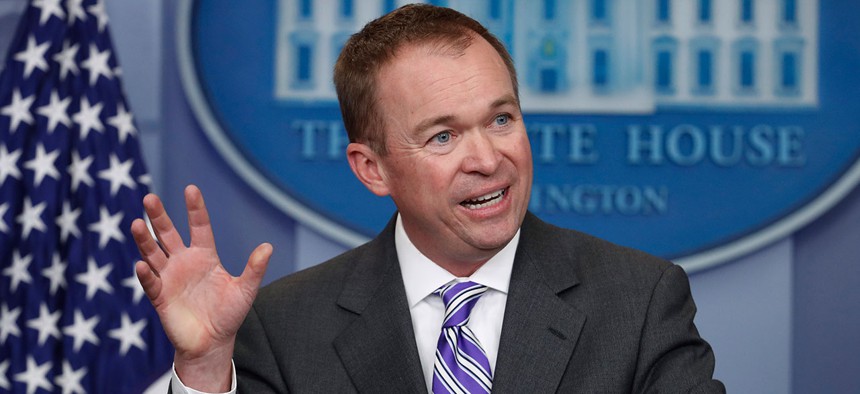Trump Is Headed for a Budget Battle
The new president is about to learn how difficult it is to get Congress to approve his spending priorities.
Here’s hoping President Trump has enjoyed the early, carefree days of his presidency, when most of his work has involved go-it- alone executive orders, appointments, pep rallies, and grousing about his mistreatment by this or that enemy of the people.
Within the next couple of weeks, things are going to get vastly less breezy, when the White House officially drops its 2018 “skinny budget” on Congress. This will give lawmakers their first real peek at Trump’s economic priorities––beyond his usual unicorns-for-all pledge to slash taxes while spending willy-nilly on things like infrastructure and immigration enforcement.
At that point, shit starts getting real.
To clarify, what the White House is handing over is not a full budget proposal. It is a “skinny budget,” which sounds like some god-awful low-calorie sludge you’d order at Starbucks, but is in fact a general overview of the president’s spending priorities for the 2018 fiscal year. As Trump budget director Mick Mulvaney stressed at a press briefing Monday, the outline will not address entitlement programs such as Social Security or Medicare; it will not tackle tax reform; it won’t get into any specifics on infrastructure; and it won’t attempt any sort of revenue projections. It will merely provide “topline” numbers on discretionary spending that the various agencies will be expected to abide by.
In other words, most of the really bloody fights will come later. Even so, there will be enough meat on these bones to start a brawl or two. Case in point: Trump’s proposed cuts to the State Department have moved Republican Senator Lindsey Graham to declare the package “dead on arrival.” So that debate promises to be lively.
More broadly, the basic structure of the blueprint—in which Trump wants to add $54 billion in defense spending by whacking an equivalent amount from non-defense programs—would blow up the 2011 sequestration agreement (which split cuts evenly between defense and non-defense programs) and thus require a change in the law in order to even be considered. But we’ll get to all that fun in a minute.
The practice of submitting a skinny budget is relatively new. The Budget and Accounting Act of 1921 requires the president to send Congress a spending plan early in each new session. The exact deadline has been tinkered with over the decades. Until 1990, however, it fell so early in January that, during presidential transitions, the decamping president was obligated to submit a budget on his way out the door, which could then be revised by his successor. (So it was that Ronald Reagan filed the underlying budget for George H.W.’s first year in office, as Carter had for Reagan, Ford had for Carter, and so on.) Under Bush 41, the official deadline was loosened just enough––from early January to early February––to enable the outgoing president to leave this duty to the incoming one, which promptly became the standard.
Practically speaking, of course, it would be madness for a fledgling White House to try to hammer out a full budget in its first couple of weeks. Thus was born the skinny budget. During their first February in office, Clinton, Bush 43, and Obama each provided a budget overview to Congress in conjunction with their first joint address to lawmakers. Such overviews typically run in the digestible 100-200- page range, rather than the doorstop-sized full budgets submitted in the spring.
(Some of the astute among you will notice that Trump has missed the early February deadline even with his skinny budget—as did those before him. As is so often the case in Washington, deadlines are forever being pushed and tweaked and ignored to the point where one might wonder why Congress bothers to keep them on the books. But that is a topic for another day.)
Already, the skinny budget is making the rounds in the executive branch. On Monday the White House sent the numbers out to federal agencies and departments in a process known as “passback.” Along with the topline amounts they are being allotted, agencies received suggestions from Mulvaney’s Office of Management and Budget on how to hit those numbers. After spending a few days reviewing the proposal, agency officials will come back to OMB with their thoughts on where the cuts—or, in the case of the Pentagon, the additional billions—should be directed. Serious appeals go up the food chain to Mulvaney or even the White House.
Further details will be fleshed out, and the budget office hopes to hand lawmakers a final outline by March 16. As Lindsey Graham’s DOA comment indicates, the White House can look forward to many spirited exchanges about its skinny budget even with lawmakers from its own party. Democrats, meanwhile, are working themselves up into a lather over the core structure of the proposal.
Specifically, popping the sequestration cap off the defense budget would require at least 60 votes in the Senate. That means recruiting a handful of Democrats to the cause. But adding billions to defense while not simply keeping a lid on non-defense programs but specifically slashing them by an equivalent amount will play poorly with Democrats. (Senate Minority Leader Chuck Schumer has already been raising holy hell about it.) White House Press Secretary Sean Spicer has expressed confidence that Democratic Senators will decline to play partisan politics with national security—suggesting that the past several weeks have taken a greater toll on Spicer’s grasp of reality than originally thought.
To be sure, Trump fancies himself the shrewdest of negotiators. And perhaps his full budget will indeed turn out to be a bipartisan work of art. In the meantime, even the skinniest of budget outlines gives lawmakers a nice fat target to rally opposition around until the final package lands in May—at which point, the real Beltway carnage can begin.







